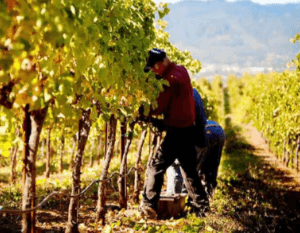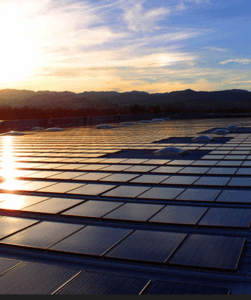Sustaining My Buzz – Readying a California Vineyard for Climate Change

To sustain the production of wine, the California wine industry will need to adapt to a new climate future.
The California wine industry is expected to be significantly impacted by the effects of global climate change, potentially resulting in decreasing California wine quality and availability. Rodney Strong Vineyards, owned by the Klein family, in Sonoma County, California, has taken a number of forward-thinking steps to address the challenges climate change faces them, yet there is still much work to be done to prepare this company for the long term future.

The expected climatic effects of climate change are well documented and are already being observed1,2. Some effects that are likely to very directly impact the California wine industry include those summarized in Exhibit 1.
Exhibit 1 – Expected Climatic Results of Climate Change and Potential Impacts on Wine Industry
| Expected Climate Result of Climate Change | Potential Impact on Wine Industry |
| Increase in atmospheric water vapor content | May affect vine growth, grape yield, and grape quality (positively or negatively) |
| Increase in precipitation and severe storms | Increased potential for damage to vineyard soils and vines, which may impact grape production and require costly repairs |
| More severe droughts3 | Reduced availability of freshwater for irrigation; increased water costs; land subsidence. Social conflicts with competing demands for fresh water and land for agriculture and habitat conservation4. |
| More extreme (both hot and cold) temperatures) | May affect vine growth, grape yield, and grape quality (positively or negatively) |
| Rising sea levels/salt water intrusion | May increase salinity of groundwater or soils underlying vineyard; May affect vine growth, grape yield, and grape quality (positively or negatively) |
| Disruption of freshwater and energy supplies | Volatility in freshwater and energy availability may strain operations and increase costs. Also may result in a more challenging regulatory atmosphere for water and energy usage. |
With the wine-making process largely being the result of the land and weather, rather than a vineyard or winemaker’s skill and operations, climate change imposes a great risk on the future quality of wine in California. However, with so many variables that will be affected by climate change (including soil and groundwater salinity, ambient air temperature, and precipitation) that influence the final grapes, there is always the possibility that these changes could have a positive impact on the final product5. Additionally, improving energy and water efficiency, increasing energy independence, and supply chain evaluations can potentially decrease costs and reduce variability overall.

Rodney Strong Vineyards has already taken a number of steps6 to increase the sustainability of its operations, to include:
- Proactively being certified by the California Sustainable Winegrowing Alliance7, earning the Fish Friendly Farming® (FFF) certification8, and reducing carbon footprint by purchasing carbon credits.
- Improved vineyard operations to be conscious of impact on fish (practicing “Fish Friendly Farming), soil conservation, water conservation, air quality, wildlife protection, and the overall ecosystem.
- Installation in 2003 of the first large solar panel system in the wine industry to generate renewable energy on-site9.
- Social equity efforts to create jobs and support local business.

While these voluntary steps toward increasing the sustainability are admirable, create a positive brand image, and may be getting ahead of potential future regulations imposed on the industry, additional steps will be needed to adequately prepare Rodney Strong Vineyards for the impacts climate change will have on their business. Specifically, the company needs to develop a long-term plan for their continued operations in light of the fact that, due to environmental changes impacting growing conditions, their existing location will likely not be conducive to growing their grapes with their current practices in the future. Potential mitigation measures to address this include:
- Outsourcing grape production to areas expected to be less significantly impacted by climate change
- Buying land elsewhere now to grow grapes on in the future (note that this option poses significant challenges in relying on environmental forecast predictions, as well as the long lead time required to develop soils and vines for wine grape production)
- Using more heat- and drought-tolerant types of grapes
- Planning financially (such as contingency budgeting) for more volatility in grape production and quality
Consideration of these long-term challenges and climate change mitigation solutions will be critical for sustaining this industry into the future and preserving our beloved California wine.
(786 words)
1Intergovernmental Panel on Climate Change (IPCC), 2007. Climate Change 2007: The Physical Science Basis, Summary for Policymakers. May 31, 2007.
2IPCC, 2013. Climate Change 2013: The Physical Science Basis, Working Group I Contribution to the Fifth Assessment Report of the Intergovernmental Panel on Climate Change [Stocker, T.F., D. Qin, G.-K. Plattner, M. Tignor, S. K. Allen, J. Boschung, A. Nauels, Y. Xia, V. Bex and P.M. Midgley (eds.)], Cambridge University Press, Cambridge, United Kingdom and New York, NY, USA, 1535 pp.
3Diffenbaugh et al., 2015. Anthropogenic warming has increased drought risk in California. PNAS Vol. 112, No. 13 (March 31, 2015): 3931-3936.
4Hannah Lee, and Patrick R. Roehrdanz, Makihiko Ikegami, Anderson V. Shepard, M. Rebecca Shaw, Gary Tabor, Lu Zhi, Pablo A. Marquet, and Robert J. Hijmans. “Climate change, wine, and conservation”. PNAS 110, no. 17 (April 23, 2013): 6907-6912.
5Ramakrishna R. Nemani and White, M.A., Cayan, D.R., Jones, G.V., Running, S.W. Coughlan, J.C., and Peterson, D.L. 2001. “Asymmetric warming over coastal California and its impact on the premium wine industry.” Climate Research 19 (November 22, 2001): 25-34.
6https://www.rodneystrong.com/our-story/sustainability/
7http://www.sustainablewinegrowing.org/
8http://www.fishfriendlyfarming.org/
9https://www.rodneystrong.com/our-story/history/



It seems as though the potential mitigation options would alter the qualities of the wine produced, and in itself pose a large risk for consumer acceptance. Changing the location of grape fields and/or the grape seeds may be too much variability. It seems as though California wineries will be cornered into either early immediate action or a collective effort across large regions and multiple wineries to ensure the existing conditions produce adequate grapes and wine. The other option would be changing consumer tastes for changing wine products.
I agree with your assessment that Rodney Strong Vineyard’s actions are inadequate to prepare for how climate change will impact their business. It seems as though they are taking more steps to become a good citizen in compliance with sustainability practices, but that they haven’t actually determined how to prepare for how climate change will (and is) impacting their business on a day to day basis. I agree with Anja’s assessment that the actual climate change presents significant variability in their growing season. I think their next steps should include diversifying their growing space in the US, product innovation (i.e. what can they make with the grapes that they do harvest?), and potentially looking into how they could profitably exit the business before it is too late.
Thank you for your insightful post on a topic near and dear to my California-wine-loving heart! As a wine lover, and recent observer of the devastating drought conditions in California, I know these issues will significantly change the dynamics in the industry for years to come. I thought the potential impact on wine industry section of your post was particularly interesting. Nearly all of the factors were potentially positive and negative for impact on the industry. Volatility in yearly production is something that vineyards have come to expect year over year, but I think that this has and will be exacerbated significantly in the future due to climate change.
This reminds me of an experience that I had last summer wine tasting in Sonoma. One of the flights we did was of a wine that had been produced from the same set of vines over a period of 5 years, where there was significant variation in extreme drought and weather fluctuations in each of the years we were tasting. No surprise, the quality of the wine changed dramatically with each year, depending on the growing conditions. Obviously, this seems like something that would have significant business implications for a producer as large as Rodney Strong. I agree the other commenters that more needs to be done by the business to protect against, or diversify this risk in the future – whether that is through migration, changing the business model, or exiting the industry. Currently, it does not seem like they’ve protected themselves well against the inevitable challenges in their future.
Great post, Cali Wino. I agree with all of the comments above that Rodney Strong doesn’t seem to have a solid strategy in place to preserve their business. As you stated in the article, grapes are extremely temperamental in terms of how they react to differing weather conditions and the steps Rodney Strong has taken will likely have a marginal effect on the quality of their grapes. As you mentioned, they need to start focusing on what they can do to protect their core product. Reducing their own carbon footprint is great, but it doesn’t matter if their product is ruined in the meantime while they try to combat climate change. I think your idea of buying land in other areas is smart as it will help the company reduce the risk of climate effects by diversifying their locations. Another tactic that Rodney Strong could take that is being employed by other wineries is to try to over-produce in the time being to help offset any poor harvests (http://www.winesandvines.com/template.cfm?section=features&content=101238).
Great post! Wine is such a fascinating topic for sustainability because of the uncertainty of how it will affect the product itself. While the changes in temperature introduce significant variability into the wine (which makes the business difficult to manage), warm and dry seasons can also develop some of the best wines available. Depending on the geographical location of a winery, climate change may push a vineyard into this sweet spot of warm and dry growing season, or push a vineyard far beyond it into an environment far too hot and/or dry to produce good grapes (e.g., see http://www.npr.org/sections/thesalt/2016/03/21/470872883/an-upside-to-climate-change-better-french-wine). Different vineyards around the world will therefore be affected differently, which means that industry players are not all similarly incentivized to solve these challenges. In the long-term, this may imply a global shift in wine-growing regions to areas that can better maintain that environmental sweet spot.
I guess this means that at the end of the world we’ll all be drinking beer . . . On a more serious note, I appreciated your post about a company that has proactively identified climate change as a key strategic challenge and begun to adopt far-sighted mitigation efforts. Given the typical productive lifetime of a vineyard, plantings today can already be expected to mature under very different climate conditions. Knowing that some companies are starting to prepare – rather than viewing climate change as purely a regulatory issue – gives me hope that we can avoid some of the enormous economic losses expected from rapid climate change.
Thanks for the post! The possibility of utilizing more drought-resistant grapes is particularly interesting to me. It is already being done with barley, with research underway to develop more water-efficient crops. The wine industry poses an interesting challenge here though. In a space where subtle qualities in the grape will to a great extent shape the quality of the product, will it be feasible to develop water-efficient grapes with the complex attributes desired by winemakers? And even if this is done successfully, will wine from a modified grape be embraced by the consumer? It will be interesting to see how consumers preferences evolve and adapt to the changes gradually introduced by climate change.
Such an interesting read! I wonder, as climate change inevitably persists, if we’ll see a move towards more widespread use of green housing facilities in areas where soil and/or climate conditions are no longer conducive to producing “good” grapes, as we’ve seen happen for other plants like the tomato. With a quick google search I found one or two vineyards that already leverage such technology (i.e. http://www.emerineestates.com/greenhouse-growing.html), but I certainly don’t think this approach is preferable, particularly given that it effectively inhibits scaling volume up, or at least makes doing so incredibly expensive from a fixed costs perspective. I’m also not certain growers would be able to perfectly manufacture the right mix of soil, precipitation and temperature within green houses, because as you allude to in your post, it seems a bit serendipitous when these factors converge to produce a particularly good vintage of wine.
Thanks for the thoughtful post – as I wine lover I certainly hope that we don’t start tasting the effects of global warming!
You mention “outsourcing grape production to areas expected to be less significantly impacted by climate change” as a possible adjustment to their operating model to mitigate climate change’s effects on Rodney Strong. Query whether the carbon footprint of this activity would be significant and if that would impact their decision to move forward with off-site growing.
Great post. Devastating to think about a world without wine.